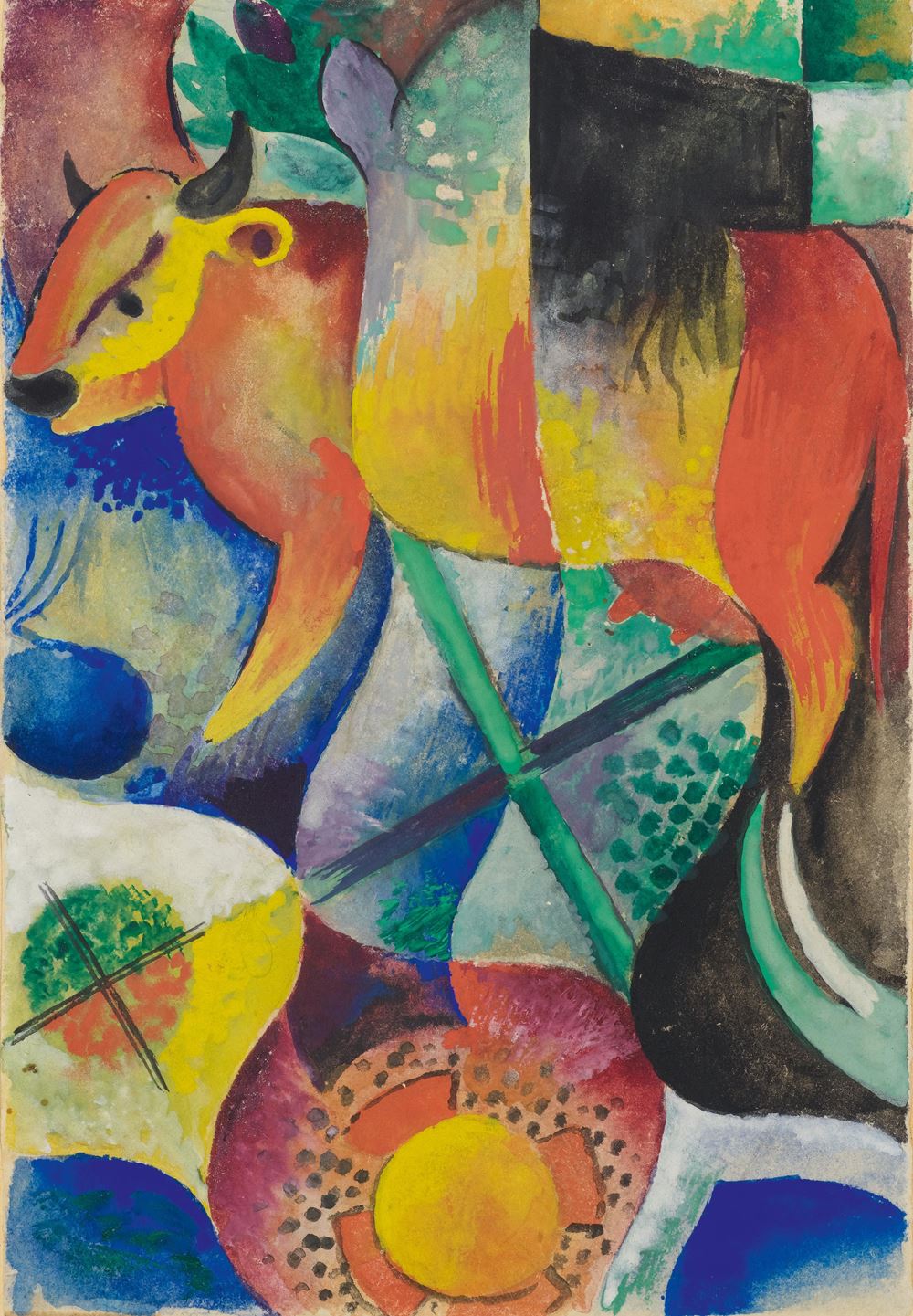
Lotto 3227* - A181 Impressionismo e arte moderna - venerdì, 30. giugno 2017, 14h00
HEINRICH CAMPENDONK
- Edith Campendonk, Amsterdam.
- Collection Dr. Hans Werner Riedel and Dr. Ralf Dieter Loher-Riedel, Munich.
Exhibitions:
- Krefeld 1960, Heinrich Campendonk. Museum Haus Lange, 22 May - 17 July (with the label on the reverse).
- Munich 1960, Heinrich Campendonk. Lenbachhaus, 29 July - 4 September, no. 13.
- Düsseldorf 1972-73, Heinrich Campendonk. Städtische Kunsthalle, 12 December - 21 January, no. 26, p. 27.
- Bonn 1973, Heinrich Campendonk. Städtisches Kunstmuseum, Städtisches Kunstmuseum, 30 January - 4 March, no. 26, p. 27.
- Munich 1976, Heinrich Campendonk - Edith van Leckwyck. Galerie Wolfgang Ketterer, no. 13 (with ill.).
Literature: Firmenich, Andrea: Heinrich Campendonk 1889 - 1957. Leben und expressionistisches Werk, Recklinghausen 1989, no. 486 G (with ill.)
"One cannot explain a picture by Campendonk because the mystery is unfathomable.
Through analysis one hackles his soul and brings about delicious enjoyment."
The phenomenon of Campendonk, as described in 1918 by his friend and writer Walter Schürmeyer.
In 1911 Heinrich Campendonk followed the invitation of Franz Marc and moved from Krefeld to Sindelsdorf. This move was the decisive impetus for his future work. His friend, Helmut Macke, established the contact with August Macke, his cousin, and the other members of the Blaue Reiter group. Through the close encounter with the other artists in Sindelsdorf and the surrounding area, Campendonk received recognition and inspiration for the special quality of his developing style: the vitality of colour, the embedding of objects into a mesh of constructive forms and the balancing between abstraction and objectivity. After arriving in Bavaria, Campendonk properly flourished. The multitude of new influences strengthened and inspired him. He was the youngest participant in the legendary first Blaue Reiter exhibition, which took place from 18th December 1911 to 1st January 1912 at the Galerie Thannhauser in Munich. Campendonk was able to develop his own concepts of image and colour through his close collaboration with Wassily Kandinsky, who had successfully broken through to abstraction in 1910 and who had developed a metaphysical colour concept in his theoretical masterpiece "Über das Geistige in der Kunst" (Concerning the Spiritual in Art), with Franz Marc, who in his color-intensive animal representations postulated the absolute harmony of animal and nature, and with the other creative comrades such as Jawlensky, Macke, Münter, Werefkin, Klee, Erbslöh or Kanolt. It was not only the meeting of very different image concepts within the Blaue Reiter community, but also the lively theoretical discourse, which lead to a unique environment in the history of art.
Campendonk's world of pictures follows its own canon: floating, persistent, interwoven, creating an autonomous mystery. His pictures are a self-contained world, the more the viewer tries to decipher them the more impervious they remain. About 100 years after Walter Schürmeyer's statement, Giesla Geiger also postulated: "The longer one engrosses oneself, the more puzzling they become." (see: Geiger, Gisela, Heinrich Campendonk, Munich 2013, p.12)
The mystery of his depictions stems from several sources. Campendonk's pictures follow a work-immanent symbolism – equivalent to the image cosmos of Marc Chagall. Always hovering at the boundary between abstraction and objectivity, the depicted never completely vanishes from mimetic representation. Rather, it gains in importance in the course of his work. The colour sequences, stylized forms, and changing depths of space dissect the pictorial content like set pieces, intersecting with each other in cubistic-like transparency and placing them into in loose connections. The influences of Pablo Picasso and Georges Braque leave traces in Campendonk's representation of space, as does the prismatic decomposition of Robert Delaunay.
A favourite motif of Campendonk is the cow or bull. Inspired by Franz Marc's animal depictions and embedded in the rural surroundings of Upper Bavaria, where cows, cats and horses are part of the everyday scenes, he painted completely absorbed in this world of images. For Heinrich Campendonk, this animal bears a dual metaphorical significance and is essential to his work, as he explained in a letter in 1908 to Adelheid Deichmann, his future wife: "In the coat of arms of St. Luke is a cow. Consequently, one must be as patient as cattle." Saint Luke, the Evangelist symbolized by the bull, is the patron saint of painting and a central motif of his guild. At the same time, Campendonk also puts the patience motif into play, the endurance and patience constantly required of the artist in the creative process.
However, the central design element employed by Campendonk is colour. "I feel more and more that my way will be the path of colour, and that I must forego everything else." (Heinrich Campendonk in a letter to Adelheid Deichmann, 1909). Early on, Campendonk extensively dealt with colour theories and created brilliant works inspired by the poetic power of the colour of Robert Delaunay. The painting offered here, "Die Kuh", is an exceptionally dense and harmonious colour composition, dominated by the complementary contrasts of red-green and orange-blue in increasing fields of tension. In 1914, in the year of the dissolution of the Blaue Reiter group, Campendonk quite confidently found his own style, allowing the individual luminous elements of colour to come together into a harmonious unity despite the geometrical and tectonic rigidity.
CHF 120 000 / 180 000 | (€ 123 710 / 185 570)
Venduto per CHF 156 500 (incl. premio dell'acquirente)
Non si assume alcuna responsabilità per la correttezza di queste informazioni.

